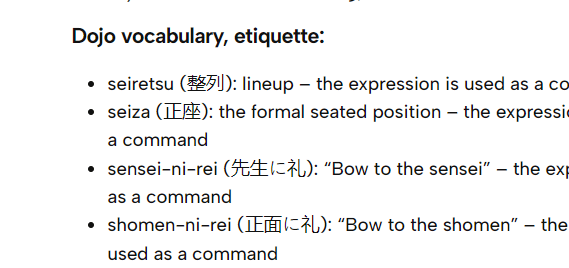You just started kendo with us? Great!
You just started kendo somewhere else? We are cool, so you are missing out, but it’s still great!
We would like to make your learning a bit smoother, so we compiled a set of basic expressions and phrases you will become acquainted with during the first 2-3 months of your kendo journey. In the end of this post, you will also see a few links to some videos we thought might be useful for you.
Please note, that many of these words also exists in other contexts. Here, we only write down their meaning, which is kendo-relevant. 1
Dojo vocabulary, etiquette:
- seiretsu (整列): lineup – the expression is used as a command
- seiza (正座): the formal seated position – the expression is also used as a command
- sensei-ni-rei (先生に礼): “Bow to the sensei” – the expression is used as a command
- shomen-ni-rei (正面に礼): “Bow to the shomen” – the expression is used as a command
- rei (礼): bow – usually used as a command
- rei-ho (法): the formal system of the movements and actions of etiquette
- osame-to (納め刀): “Put away your weapon.” – the expression is used as a command
- otagai-ni-rei (お互いに礼): “Bow to your peers.” – the expression is used as a command
- kamae (構え): basic stance – the expression is usually used as an imperative, of giving a command to the practitioners to take the basic stance
- chudan-no-kamae (中段の構え): “middle-level” kamae
- sonkyo (蹲踞): the formal crouching position in kendo
- sage-to (下げ刀): the relaxed position, in which one’s shinai is held at their side
- onegaishimasu (お願いします): “Let me train with you.” – this expression is generally used before starting a specific exercise (incl. waza practice and jigeiko) with your opponent
- keiko (稽古): practice, training
- hajime (始め): start – this expression is usually used as an imperative, indicating that the practitioners should start the exercise
- yame (止め): stop – this expression is usually used as an imperative indicating that the practitioners should stop the exercise
- yasume (休め): rest – this expression is usually used as an imperative, indicating the the practitioners can rest
- arigatogozaimashita (ありがとうございました): “Thank you very much.” – this expression is generally used after finishing a specific exercise (incl. waza practice and jigeiko), or the entire keiko.
- kendoka (剣道家): kendo practitioner
- shomen (正面): the symbolic “main space” or “head” of the dojo
Numbers:
- ichi (一): 1
- ni (二): 2
- san (三): 3
- shi/yon (四): 4
- go (五): 5
- roku (六): 6
- shichi/nana (七): 7
- hachi (八): 8
- kyu (九): 9
- ju (十): 10
Footwork – ashisabaki – 足捌き:
- suri-ashi (摺り足): the “sliding steps” that are used in kendo
- okuri-ashi (送り足): the standard footwork used in kendo (i.e. the application of suriashi)
- ayumi-ashi (歩み足): a motion of walking, where the feet cross one another – the motion is done with suri-ashi in kendo
- hiraki-ashi (開き足): a semi-circular step to the left or right, mostly used when practicing naname-buri
- fumikomi (踏み込み): the lunging style of footwork that momentarily foregoes suri-ashi and results in a stomping sound as the leading foot lands on the floor
Striking practice – suburi – 素振り:
- men-uchi (面打ち): strike on the head
- kote-uchi (小手打ち): strike on the forearm
- do-uchi (胴打ち): strike on the abdomen
- tsuki (突き): thrust on the throat
- sayu-men (左右面): angled strike of the left and right sides of the men
- joge-buri (上下振り): a basic form of striking, usually used in warm-up that is executed until approximately one’s own knee-height in the center line of their body
- naname-buri (斜め振り): similar to joge-buri, with an approximately 30°–45° angle of the strike
- nidan-waza (二段技): two-step waza, e.g., men-men, kote-men, kote-do
- sandan-waza (三段技): three-step waza, e.g., men-men-men, kote-men-men
Equipment:
- shinai (竹刀): bamboo sword
- hakama (袴): the traditional “practice pants”
- gi (着): the practice “jacket” – also known as kendo-gi, do-gi, keiko-gi
- bogu (防具): the armor, consisting of men, kote, do, and tare – also known as kendo-gu
- tsuru (弦): the string connecting the saki-gawa and the tsuka-himo on the shinai
- saki-gawa (先革): the leather cap on the top of the shinai
- tsuka-himo (柄紐): the leather that attaches the tsuru to the tsuka-gawa
- tsuka-gawa (柄革): the leather covering the handle of the shinai
- nakayui (中結): the leather on the 1/4th length from the top of the shinai
Supporting videos:
- manners and etiquette, more manners and etiquette
- footwork and fumikomi and more fumikomi
- kamae, sonkyo
- suburi
- kirikaeshi
- If you are pondering about the transliteration: we took the easy way out. ↩︎


Leave a Reply